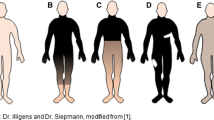Abstract
Objectives
Postural tachycardia syndrome (POTS) is a heterogeneous disorder characterized by excessive orthostatic tachycardia in the absence of orthostatic hypotension and by sympathetic nervous system activation. Postganglionic sudomotor deficits have been used to define a neurogenic postural tachycardia POTS subtype. Norepinephrine levels above 600 pg/ml have also been used to delineate patients with a hyperadrenergic state. This study aims to determine the relationship of sudomotor abnormalities to other aspects of dysautonomia in POTS.
Methods
Autonomic function was quantified in thirty women through tests of cardiovagal, adrenergic, and sudomotor function including quantitative sudomotor axon reflex testing (QSART) and spectral indices. Differences between patients with and without sudomotor dysfunction as defined by QSART and between patients with and without hyperadrenergic POTS were assessed with Mann–Whitney U test and Mantel–Haenszel Chi-Square test using a p value of 0.01 for significance. Spearman correlation coefficients were used to test raw sweat volume correlations with other variables.
Results
Of 30 women (ages 20–58), 17 patients (56%) had an abnormal QSART which was typically patchy and involved the lower extremity, while 13 patients had normal QSART results. Other autonomic tests, catecholamines or spectral indices did not correlate with QSART results. No differences in autonomic tests or spectral indices were observed between hyperadrenergic and non-hyperadrenergic POTS.
Interpretation
Our findings confirm that a large subset of POTS patients have sudomotor abnormalities which are typically patchy in distribution but do not correlate with other tests of autonomic function. Further studies are needed to determine the best method of endophenotyping patients with POTS.
Similar content being viewed by others
References
Robertson D (1999) The epidemic of orthostatic tachycardia and orthostatic intolerance. Am J Med Sci 317(2):75–77
Jacob G, Biaggioni I (1999) Idiopathic orthostatic intolerance and postural tachycardia syndromes. Am J Med Sci 317(2):88–101
Raj SR, Robertson D (2007) Blood volume perturbations in the postural tachycardia syndrome. Am J Med Sci 334(1):57–60
Vernino S, Low PA, Fealey RD, Stewart JD, Farrugia G, Lennon VA (2000) Autoantibodies to ganglionic acetylcholine receptors in autoimmune autonomic neuropathies. N Engl J Med 343(12):847–855
Schondorf R, Low PA (1993) Idiopathic postural orthostatic tachycardia syndrome: an attenuated form of acute pandysautonomia? Neurology 43(1):132–137
Jacob G, Costa F, Shannon JR, Robertson RM, Wathen M, Stein M et al (2000) The neuropathic postural tachycardia syndrome. N Engl J Med 343(14):1008–1014
Thieben MJ, Sandroni P, Sletten DM, rud-Larson LM, Fealey RD, Vernino S et al (2007) Postural orthostatic tachycardia syndrome: the Mayo clinic experience. Mayo Clin Proc 82(3):308–313
Novak V, Novak P, Opfer-Gehrking TL, Low PA (1996) Postural tachycardia syndrome: time frequency mapping. J Auton Nerv Syst 61(3):313–320
Al-Shekhlee A, Lindenberg JR, Hachwi RN, Chelimsky TC (2005) The value of autonomic testing in postural tachycardia syndrome. Clin Auton Res 15(3):219–222
Goldstein DS, Eisenhofer G, Stull R, Folio CJ, Keiser HR, Kopin IJ (1988) Plasma dihydroxyphenylglycol and the intraneuronal disposition of norepinephrine in humans. J Clin Invest 81(1):213–220
Low PA, Denq JC, Opfer-Gehrking TL, Dyck PJ, O’Brien PC, Slezak JM (1997) Effect of age and gender on sudomotor and cardiovagal function and blood pressure response to tilt in normal subjects. Muscle Nerve 20(12):1561–1568
Diedrich A, Jordan J, Tank J, Shannon JR, Robertson R, Luft FC et al (2003) The sympathetic nervous system in hypertension: assessment by blood pressure variability and ganglionic blockade. J Hypertens 21(9):1677–1686
(1996) Heart rate variability. Standards of measurement, physiological interpretation, and clinical use. Task Force of the European Society of Cardiology and the North American Society of Pacing and Electrophysiology. Eur Heart J 17(3):354–381
Oppenheim AV, Schafer RW (1996) Digital signal processing. Prentice–Hall, New Jersey
Hoeldtke RD, Davis KM (1991) The orthostatic tachycardia syndrome: evaluation of autonomic function and treatment with octreotide and ergot alkaloids. J Clin Endocrinol Metab 73(1):132–139
Muenter SN, Charkoudian N, Dotson RM, Suarez GA, Low PA (2005) Baroreflex control of muscle sympathetic nerve activity in postural orthostatic tachycardia syndrome. Am J Physiol Heart Circ Physiol 289(3):H1226–H1233
Bonyhay I, Freeman R (2004) Sympathetic nerve activity in response to hypotensive stress in the postural tachycardia syndrome. Circulation 110(20):3193–3198
Goldstein DS, Holmes C, Frank SM, Dendi R, Cannon RO III, Sharabi Y et al (2002) Cardiac sympathetic dysautonomia in chronic orthostatic intolerance syndromes. Circulation 106(18):2358–2365
Singer W, Spies JM, McArthur J, Low J, Griffin JW, Nickander KK et al (2004) Prospective evaluation of somatic and autonomic small fibers in selected autonomic neuropathies. Neurology 62(4):612–618
Low PA, Opfer-Gehrking TL, Textor SC, Benarroch EE, Shen WK, Schondorf R et al. (1995) Postural tachycardia syndrome (POTS). Neurology 45(4 Suppl 5):S19–S25
Khurana RK (1995) Orthostatic intolerance and orthostatic tachycardia: a heterogeneous disorder. Clin Auton Res 5(1):12–18
Barontini M, Lazzari JO, Levin G, Armando I, Basso SJ (1997) Age-related changes in sympathetic activity: biochemical measurements and target organ responses. Arch Gerontol Geriatr 25(2):175–186
Acknowledgments
This study was funded by the National Institutes of Health NINDS 1K23 NS056009-01A1; P01 HL056693, R01 HL071784, NIH/NCRR K23 RR020783, and by Vanderbilt CTSA grant 1 UL1 RR024975.
Author information
Authors and Affiliations
Corresponding author
Rights and permissions
About this article
Cite this article
Peltier, A.C., Garland, E., Raj, S.R. et al. Distal sudomotor findings in postural tachycardia syndrome. Clin Auton Res 20, 93–99 (2010). https://doi.org/10.1007/s10286-009-0045-y
Received:
Accepted:
Published:
Issue Date:
DOI: https://doi.org/10.1007/s10286-009-0045-y




